

by Young Londoners

Julian Germain “For every minute you are angry you lose sixty seconds of happiness” project
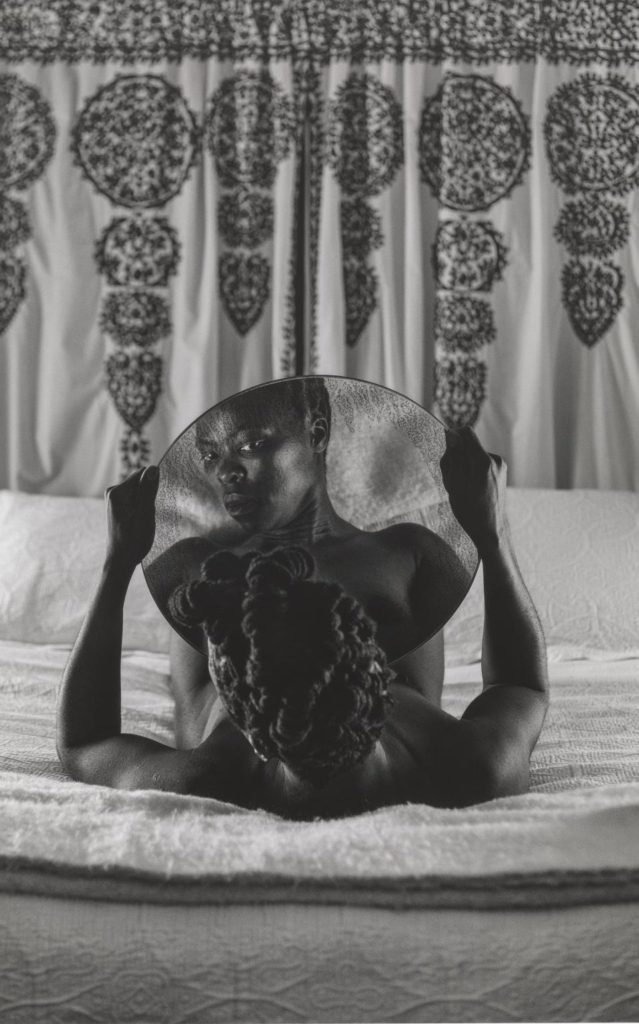
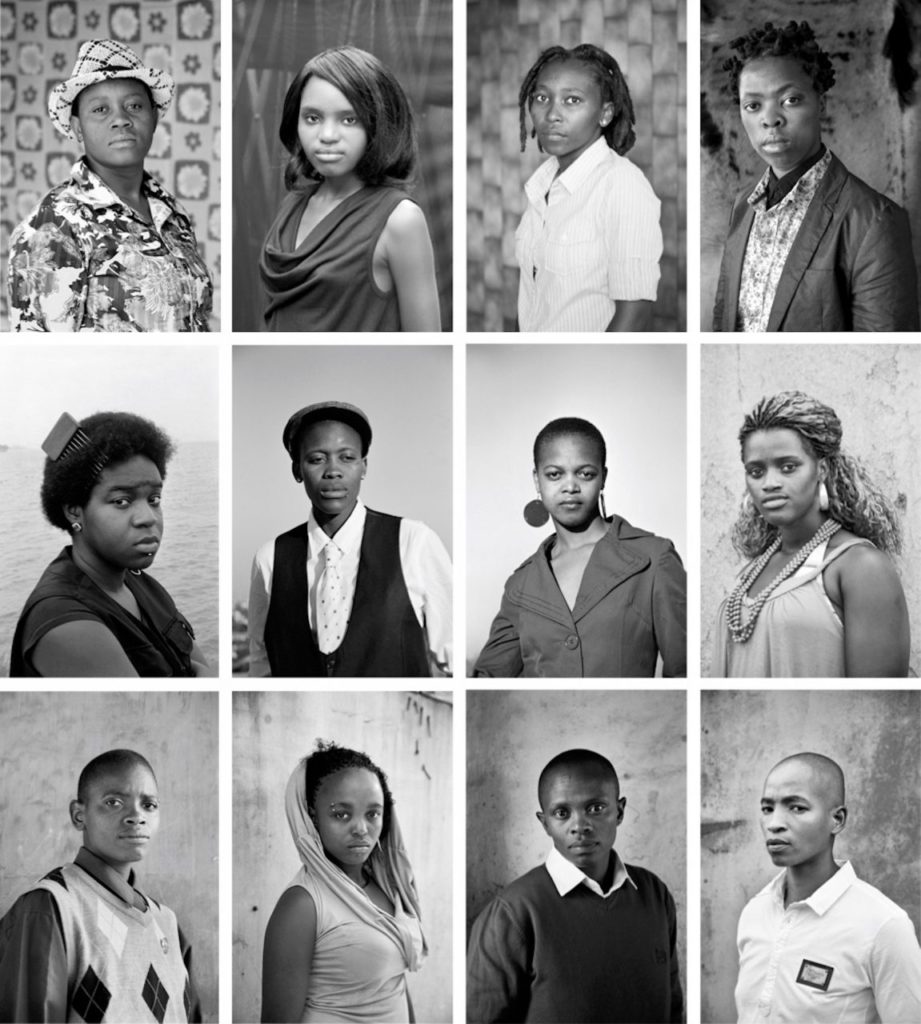


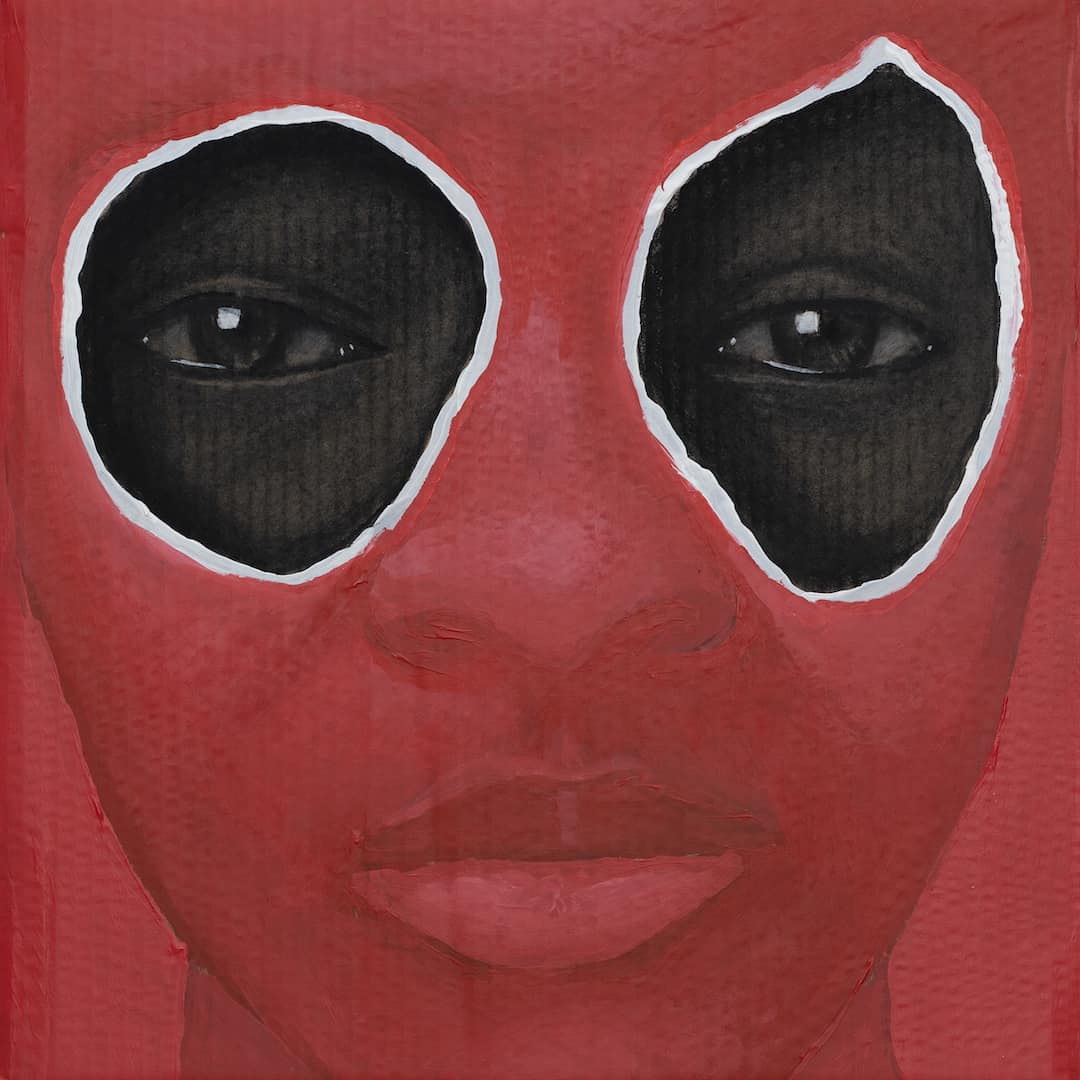








https://web.microsoftstream.com/video/ebad8b1c-a10f-4ba2-b4bd-803164699d50?list=studio
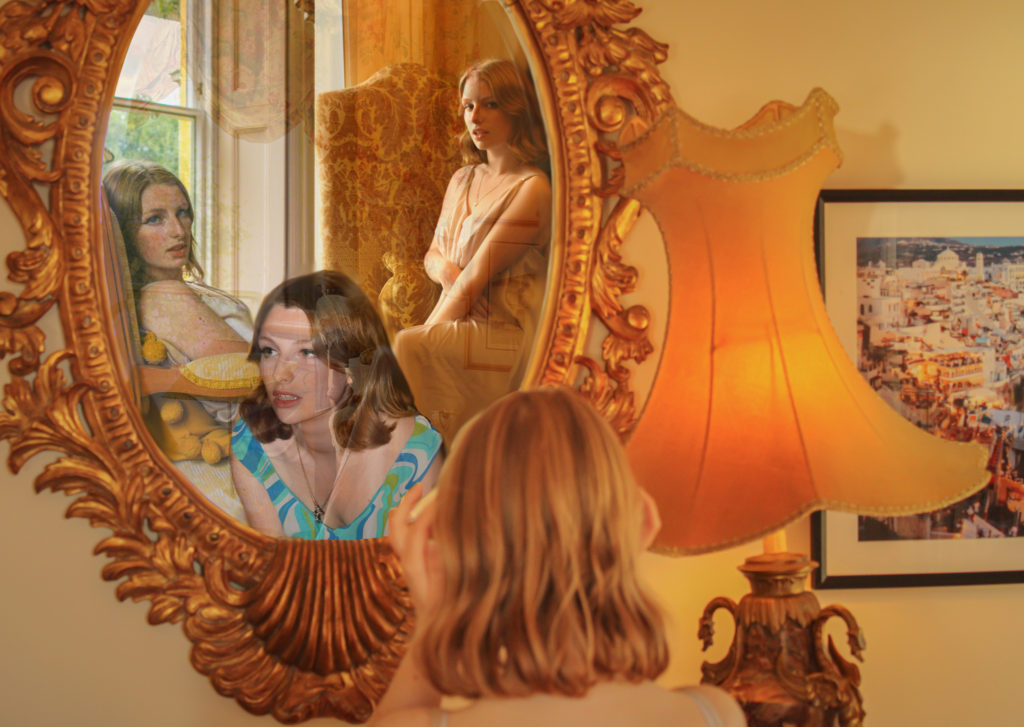
Overall, I believe that our final image and film have turned out very successful as they relate strongly to our initial intentions of commemorating the women who have fought for their own rights throughout history. I am really proud of what we have accomplished during this project, learning new skills on different software such as Premier Pro has been really beneficial in discovering the limitless elements of photography and all we can do with it. I believe our final film succeeded greatly due to our setting, lighting, camera angle and casting – using a model who has such a timeless look helped us portray different decades and styles which all together sustained the aesthetic of our film. Additionally changing our idea to using a static camera shot, instead of panning along as the model moved, assisted with the fluidity of each video; we developed our ideas well as a team by working together and listening to each other’s input. I believe that our message comes across clearly in our film through our use of visual imagery and audio, the idea to use clips from historical interviews helped focus on our main objective. Our final image was created by choosing our 4 favourite images from our shoot and editing them together to form a collage as if our model were seeing different versions of herself through a mirror. I believe we really captured a sense of pride in this image, it represents looking back on the empowerment and rights we have been given by our ancestors, feeling confident in oneself of all that has been accomplished. One part of this image that I think works particularly well is its repetition of the colour orange, symbolising strength and confidence being such a bold colour while also keeping a theme of regality throughout. If we were to have more time on this project I would have liked to improve my skills in digital animation using Adobe After Effect, we brainstormed how we could use this software in our final film but couldn’t come up with an idea of the right standard. Nevertheless, I am extremely pleased with how our final film and image have evolved and developed – I believe they represent a fight for gender equality and female empowerment successfully.
The evolution of women’s rights into the future Metaverse, a time when diversity and equality are the norms, where a woman can choose what she does with her body without the input from the government and society around her. The concept of our NFT film is to explore the three major waves of feminism in the last 100 years and to celebrate the women who have fought for women in the present to have equal rights to men. The name of our film came from a play on words for Mankind, because as a society in general we are referred to regarding men, by switching the prefix Man to Woman we are making a statement on the power of women collectively. We capitalised the K as an ironic reference to the stereotype of women being gentle and sweet-tempered. Conveying ideas about women’s rights throughout the years, suffragettes, protesters and so on, we show the cyclical theme of women standing up for what they believe in and gaining confidence, that we should all have, in themselves.
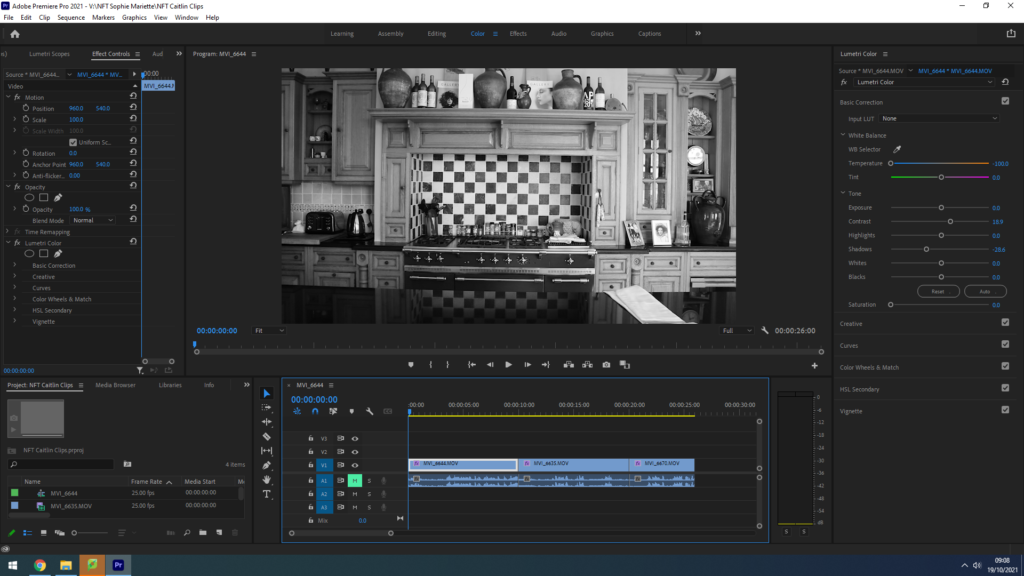


While on location filming our NFT video, using our plans from the storyboard we created, my group chose three rooms in the house that rightly portrayed our three different eras. The first room shows a rustic, un-modernised kitchen with antique original tiles and cabinets to represent our early 1900’s housewife’s home. The lighting in this room was perfect for filming, with large windows spanning from the ceiling to the floor right in front of where we planned to set up the camera, providing perfect natural light to set the scene and highlight our model’s face. To fit with our idea of showing different decades, we edited this clip with a black and white filter to replicate old silent films. We also really loved the range of geometric shapes in this location as it hinted towards the idea of order and tidiness, stereotypical ‘housewife qualities’ that broke down as our video went on. Our next room we chose was a living area with two red patterned sofas relating to those of the 60’s and 70’s, we loved the minimalistic background of this shot as the blank orange walls provided lots of negative space to draw the observer’s attention towards our models actions. We felt a need to increase the vibrancy of each clip as our film went on, therefore we edited with lower saturation and warmer tones that were more reminiscent of old film camera photographs. However, the one part of this location that could steal the observer’s gaze, for all the right reasons, was the watercolour painting of a woman sat in a field of flowers. We really loved having this painting in the centre of our shot as it conveyed the feminine stereotypes we were highlighting in this whole project, relating back to our embroidery inspiration of ‘The Bugs and the Lovers’ and keeping that motif of flowers flowing throughout our piece. Our final location for representing the modern day woman, confident and assured of herself, was anther living/office area that held a grand mirror that had regal tones of wealth and luxury. As described in our storyboard, we wanted to feature a mirror for our model to admire herself in before leaving frame, and we thought this one was perfect. The golden warm tones from the artificial lighting also helped provide links to happiness and comfort in our final shot.

We wanted to create a piece of inspiring audio with links to moments in history that defined waves of the feminist movement to play underneath our film, of course due to copy right we had to find a piece of royalty free music. I researched the free music website Audio Library and found composer Scott Buckley – his instrumental song ‘Luminance’ worked perfectly for our film, with elements of drama, suspense but an overall a calm atmosphere to be juxtaposed with historical audio clips, this piece of music worked well. We also had the idea to find clips from certain women’s rights activists throughout history to layer over the top of this instrumental track. I searched on YouTube to find feminism interviews, our first is taken from Christabel Pankhurst’s 1908 speech recording, protesting for the women’s right to vote, she states ‘the ministers suffragettes, who form the women’s social and political union, are engaged in the attempt to win the parliamentary vote for the women of this century’. Our second historical audio recording is from a NBC news report in the 1970’s on the Women’s rights movement, this woman states ‘we now have ten million women backing this particular measure before congress, that’s ten million women who are united through their organisation.’ Our final audio recording is representing the modern woman of empowerment and self love, it is from Britta Badour’s 2019 poem entitled ‘Dear Young Woman’ where she reads ‘whatever you’re going through as a woman, you have the choice to make for yourself for how gentle and kind you are with yourself’. In Adobe PremierPro, I layered this audio clips over each other to create a piece of sound that told a story throughout our films movement.


During our video editing process we experimented with how creating a montage for the end of our film would impact the overall message. We wanted to find images from several different decades, highlighting the suffragettes/suffragists as well as present day women fighting for equality and the rights to their own bodies. Each member of our group researched some of the most prominent protests/marches for equality in history, collating a set of images that we wanted to include in our montage. Using a mix of black and white/colour images was something we really wanted to feature. After choosing each photograph we wanted in our montage, we used Adobe Photoshop to create a GIF of our images using the instructions below;
How to make a GIF in Photoshop
1. Create layer for each image
2. Window > timeline
3. Select > Create Frame Animation
4. Drop Menu > Make frames from Layers
5. Timeline > select Forever
6. File > Export > Save for Web Legacy > reduce image size to 720 x 720 pixels
By using a GIF format to create our montage it gave us the ability to speed up the duration of each image, producing a fast paced series of photos that sat in time with the music underscoring our film. We wanted this montage to go at the end of our film to really finalize our message that these issues of inequality are still going on to this day.

As a group we discussed developing a title that summarised our views and message altogether. We came up with the idea of ‘WomenKind’ – a play on words for ‘mankind’, a word that is meant to refer to the whole human race however only refers to the male gender in the process, switching to ‘Woman’ to create a statement on collective women empowerment. We are not suggesting in this pun, or in this entire project, that women are better than men – that idea has been mentioned nowhere – we are simply drawing attention to the fact that for centuries women and men alike have fought for female empowerment and gender equality, we are giving our thanks and telling their stories. Additionally, we decided to capitalise the ‘K’ in kind to hint at the irony surrounding the stereotype of women being weak and submissive, showing kindness to all. This is clearly juxtaposed with our film celebrating the strong powerful women who still continue to fight for equality, our title highlights and challenges the parodic representation of women throughout history.
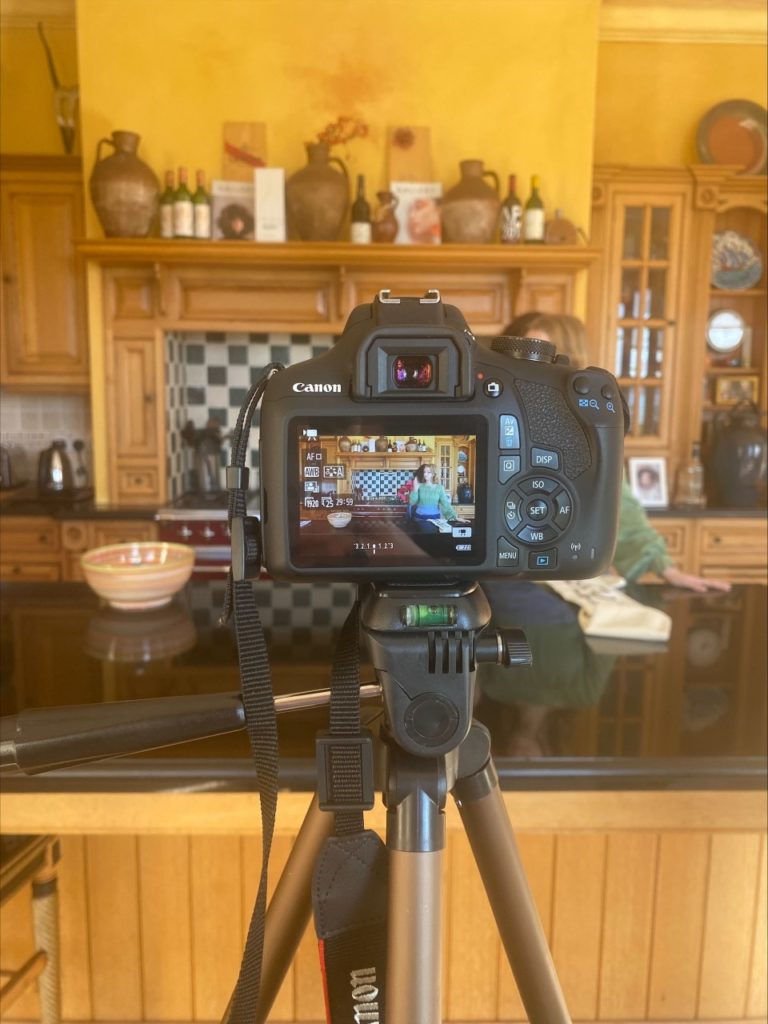



Bayeux Tapestry
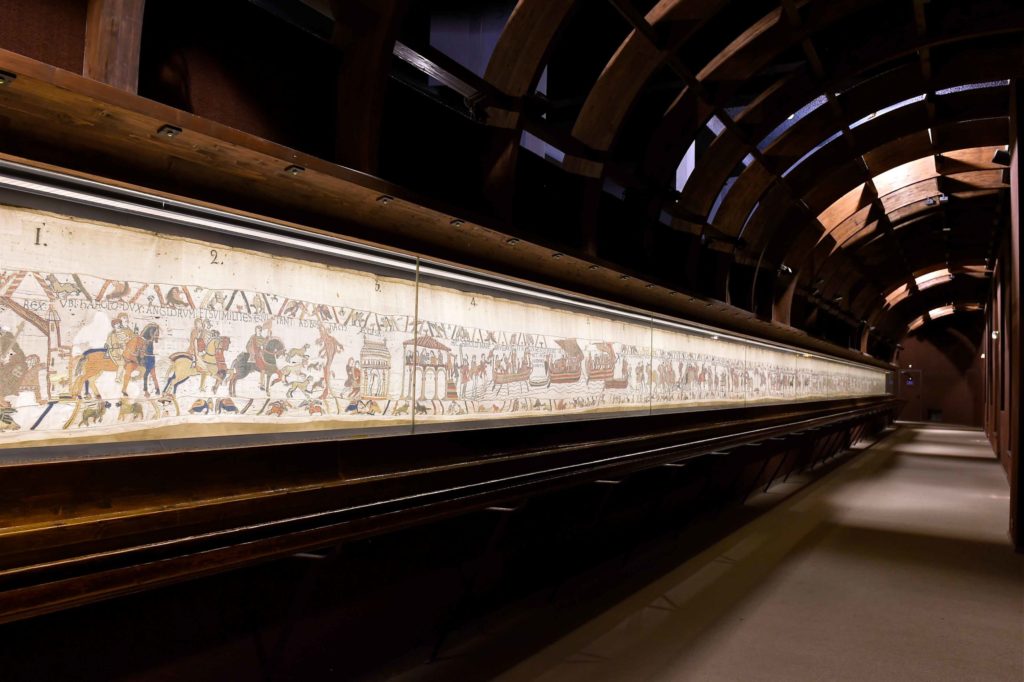
The Bayeux Tapestry is an embroidered cloth nearly 70 metres long and 50 centimetres tall that depicts the events leading up to the Norman conquest of England concerning William, Duke of Normandy, and Harold, Earl of Wessex, later King of England, and culminating in the Battle of Hastings.
It was commissioned to celebrate the ‘William the Conqueror’s’ conquest of England. It begins with the events that led up to it – the death of Edward the confessor the King of England, and the succession of a new king; Harold. It runs through each scene of the Normans invasion and ends in the killing of King Harold.

The Bayeux tapestry is one of the supreme achievements of the Norman Romanesque. Romanesque art is the art of Europe from approximately 1000 AD to the rise of the Gothic style in the 12th century.
https://www.britannica.com/art/Romanesque-art
The Channel Islands became part of the Anglo-Norman realm when William the Conqueror defeated King Harold and won the English crown at the Battle of Hastings in 1066. Jerseymen, or at least close relatives, serving under their Normandy lords, were said to be present at this historical battle. Just who was and was not at Hastings has been the subject of argument for centuries, but Onfroi, Mauger and Roger de Carteret, the sons of Godefroi de Carteret, are believed to have fought in the battle. It is likely that Onfroi’s son Renaud was the first de Carteret to become established in Jersey, and was thus the founder of the dynasty which ruled Jersey for such long periods over the centuries.
The tapestry is actually not a “true” tapestry in which the design is woven into the cloth in tapestry weave; it is technically an embroidery. It was embroidered on tabby-woven linen in crewel. It uses two main types of stiches: backstitching for the lettering and outlines and coaching for filling in the figures. Nine linen panels were sewn together to make the full 70m piece.
At least two panels of the tapestry are missing, perhaps even another 6.4 m . This missing area may have included William’s coronation.

The tapestry is now exhibited at the Musée de la Tapisserie de Bayeux in Bayeux, Normandy, France. https://www.bayeuxmuseum.com/en/the-bayeux-tapestry/
Lisa Reihana
Lisa Reihana is a New Zealand artist of Maori descent.
is a moving image interpretation of the French scenic wallpaper Les Sauvages de la Mer Pacifique.
In Neoclassical France, entrepreneur Joseph Dufour used the latest printing innovations to produce Les Sauvages de la Mer Pacifique (1804), a sophisticated twenty panel scenic wallpaper. Mirroring a widespread fascination with the Pacific voyages undertaken by Captain Cook, de Bougainville and de la Perouse, the wallpaper’s exotic themes referenced popular illustrations of that time. Two hundred years later, Maori artist Lisa Reihana employs twenty-first century digital technologies to animate Les Sauvages de la Mer Pacifique. Enlivened with the sights and sounds of dance and cultural ceremonies, a vast video panorama is populated by a myriad of people drawn from across New Zealand and the Pacific.
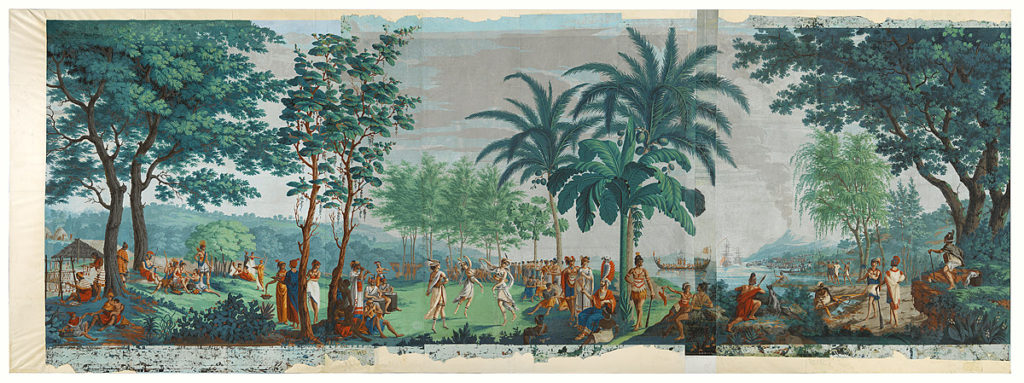
Separated by two centuries, both the wallpaper and video are set against an utopian Tahitian landscape. While Dufour’s work models Enlightenment beliefs and ideas of harmony amongst mankind, Reihana’s reading of the past is darker and more nuanced. The artist foregrounds the complexities of cultural identity and colonisation by including scenes of encounter between Europeans and Polynesians.
in Pursuit of Venus is a major video project that has been in development for several years. It reflects the wallpapers utopian ideals, is eight minutes long and presented on two-screens. in Pursuit of Venus has been exhibited in historic homes, art galleries and museums – repurposing each presentation offers new insights and unique presentation opportunities.
This epic piece of living, moving, animated wallpaper eventually led to her representing New Zealand at last year’s Venice Biennale, where it was described as the best exhibit by critics including those from the Spectator and the Sunday Times.
Read article HERE in the Guardian and watch Lisa discuss the making of her film.
Embroidery
I learnt a lot from my experience with embroidery. Initially some inspiration based stimulus, to gain inspiration into a more tangible world of art, was given to us. I studied the work of El Anatsui who is a Ghanaian sculptor who’s work focuses on reusing materials in an in orthodox way to give it new meaning. Such as this piece below where he uses bottle caps to create a piece that looks flexible and embodies themes of consumption, transformation and the environment.

We then learnt about the different types of stiches we could attempt to use in our work.

I made use of the back and the satin stich the most. The back stitch is a good method to create a continuous line. It involves, as the name suggests, stitching cloth in a line and then stitching back onto that line to make it more continuous. Satin stitching is an effective way of filling/colouring in a section of your work and it involves a consistent long portion of string being stitched parallel to fill in a space. Below is an example of where I used these methods in the same piece of tapestry.

My embroidery experience involved a lot of experimenting and compiling of many different elements.
Because there was free reign of creativity I almost allowed my hand to guide the string where I wanted it to go to create visual elements that popped into my head. I decided to create a piece with a central focus with other elements and materials sewed to it.
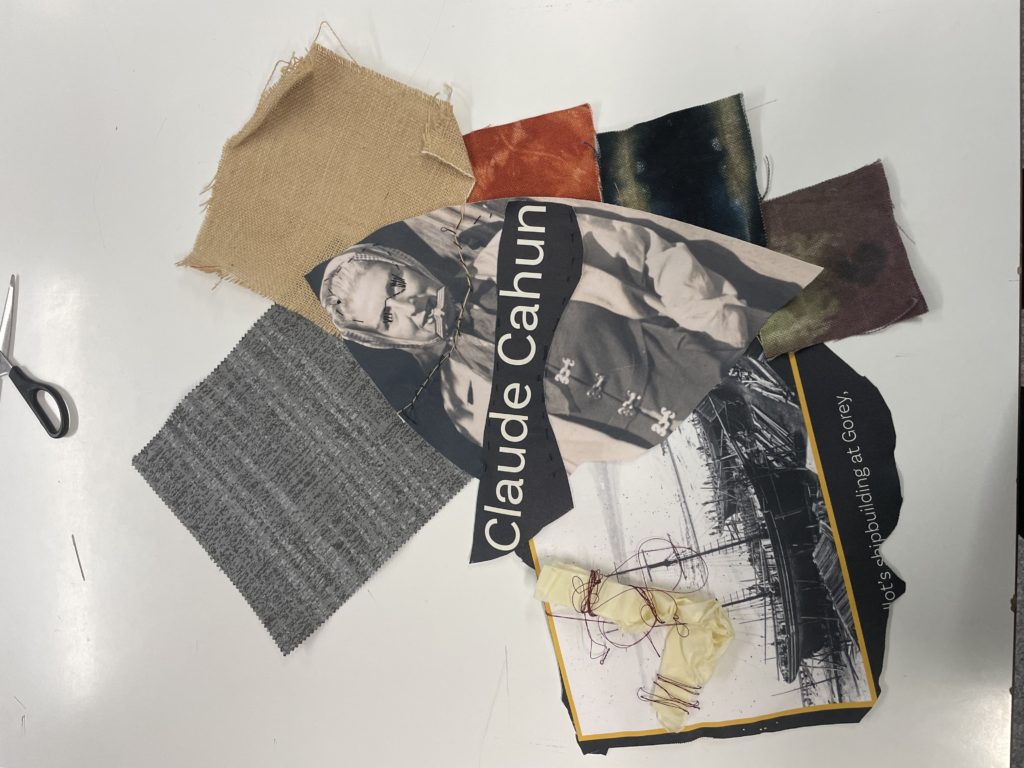
My focal image was that of influential figure in the occupation and art scene of Jersey, Claude Cahun. I additionally decided to use various stitching methods to create an intriguing design around her face to mask her eyes representing the oppression she faced during the occupation.
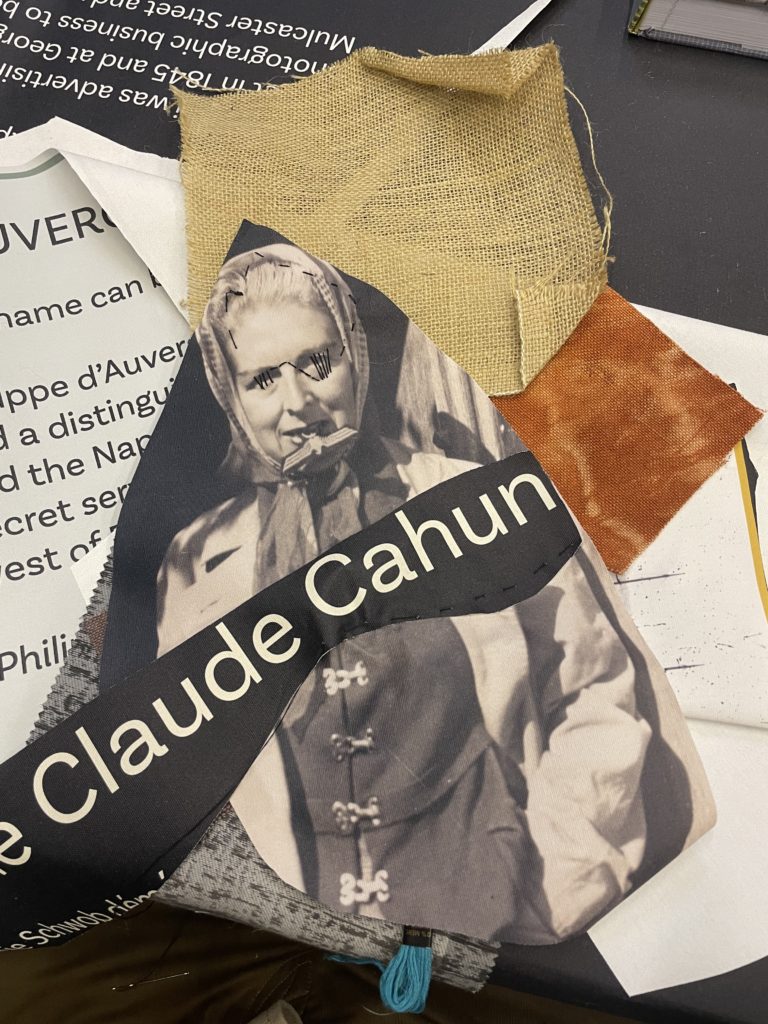
To further showcase my workflow around my embroidery I created a GIF by taking continuous photos of my piece every few minutes. I created it in photoshop by following these steps:
1. Create layer for each image
2. Window > timeline
3. Select > Create Frame Animation
4. Drop Menu > Make frames from Layers
5. Timeline > select Forever
6. File > Export > Save for Web Legacy > reduce image size to 720 x 720 pixels

I believe making this gif inspired thoughts of how tangible art can be infused with digital art. I believe using inspiration from the work of Lisa Reihana this GIF can be developed into a more in depth digital movie with the addition of a narrative. The GIF could be improved by taking images more frequently to create a smoother animation and keeping the embroidery in the same location of the table – not move it around as much.
The ISLAND IDENTITY project has produced a website and a report that has identified distinctive qualities of island life in Jersey. We were tasked with producing a poster based on one of the following themes :
Constitution & Citizenship
Communities
International
Economy
Education & Sport
Heritage, Culture & the Arts
Environment


‘Heritage is not confined to looking backwards in time but is an essential part of the present we live in and the future we build. It is the extraordinary range of landscape, monuments, experiences and stories that characterise Jersey, and it also encompasses our contemporary interactions with this inheritance and the meanings we ascribe to it. Heritage gives the Island its distinctive look and feel, attracts tourists, and can inspire both intercultural dialogue and a shared sense of place and belonging. Jersey is unusually rich in tangible heritage assets, some of which (such as the prehistoric site at La Cotte and Le Câtillon Bronze Age hoard) are of international significance. Fourteen thousand Islanders – one seventh of the population – are members of Jersey Heritage. However, the sector has suffered from chronic underfunding, a lack of dedicated Ministerial input, and the lack of a coherent Heritage Strategy for the Island, all of which the Board suggest be rectified as soon as possible.’
‘Jersey has a rich tradition of artistic endeavour, and an enviable intangible cultural heritage. This is not just historical; contemporary Islanders are producing high-quality work often inspired by the character of the distinctive place in which they live. From music to filmmaking, from painting to poetry, scores of Jersey citizens are now making careers and reputations at international level. The Board celebrated the fact that creative people and entrepreneurs clearly feel a sense of attachment and pride in the Island, and noted that some excellent organisations (such as ArtHouse Jersey) and events (such as the Festival of Words and the ‘Weekender’) are helping to put the Island on the global cultural map. However, given the extraordinary potential of art and culture to achieve almost all of the objectives associated with Identity – domestic and international – it felt that even more could be done in this sphere. The Board singled out the Battle of Flowers as an exemplum of the enormous power of cultural activity to express identity and provide an important social ritual. Its real value should be recognised by Government not as a tourist attraction as something which unites our communities in a creative, artistic endeavour. If le Carnaval de Granville can achieve UNESCO Intangible Heritage status, why not the Battle?’
https://islandidentity.je/report/heritage-culture-and-the-arts
WHAT MAKES JERSEY SPECIAL AND WHY DOES IT MATTER TO YOU?
I think that what makes Jersey special is the widespread diversity which can be seen throughout the island, and the strong sense of kinship and community which fuels everybody to interact with each other in a kind and friendly way. Additionally, as the island is so small, people tend to interrelate more closely with each other, both in their working environment and their social lives.
WHAT DOES IT MEAN TO BE ‘JERSEY’, NOW AND IN THE FUTURE?
Being ‘Jersey’ means living in a close, tight-knit community full of various cultures and ethnic backgrounds, which will hopefully grow and flourish. In the future, I would like to see more representation of our diversity through different mediums, such as the arts.
WHAT CAN WE ALL DO TO SOLIDIFY A COHESIVE AND POSITIVE ISLAND IDENTITY?
In order to solidify a cohesive and positive island identity I think that Jersey should aim to be more welcoming to those who are different from ourselves (i.e different backgrounds and cultures). If we want to create a positive place for everyone to live then we as an island need to ensure that everyone, no matter where they may come from, feels comfortable, safe, and happy.
ARE THERE BARRIERS TO A POSITIVE AND INCLUSIVE ISLAND IDENTITY? (WHAT REQUIRES A GREATER FOCUS AND WHAT IS BEING MISSED?)
I think that there will always be barriers to a completely positive and inclusive island, as some people may not share the collective mindset that everyone is welcome. In order to combat this, we need to ensure that there are places people can go if they ever feel unsafe. In addition, school-age children should be offered a more in detail education about different cultures around the world, not just their own.
Statement
Title: Online / Offline
The concept behind our NFT video is that two friends each have two separate lives; one offline and online. Our video shows how anything can happen on an online medium, but real connection and friendship occurs in real life. As technology develops relationships of all kinds are growing apart. An example of this occurred in the height of the Covid-19 pandemic lockdown. People only experienced contact with family members in the same household and the only way to speak to people outside was via an online medium. This effected the mental health of everyone and looking back on the first lockdown we can see how much we relied on technology to keep connected with family and friends.
Creators: Oliver Shiplee, Matthew Brown, Michael Kenealy and Reuben Jeanne
Evaluation
Overall, I think that the film looks good and covers our original intentions, which was to show how you could know someone in real life, but they can be completely different online. In addition, how the online world brings people together in unusual times, such as Covid-19.
The quality of the video is decent, this is because the clips go together and work well with the animated videos. However, the camera shot videos were a bit shaky, which meant they were harder to edit, for example the half-real life, and half-animated side.
Furthermore, Michael and Reuben did a good job editing the film together, especially to the beat of the music. The special effects really help convey the meaning and direction the video was going towards, which is the online/offline comparison. For example, the loading… effect helps show that Michael is travelling into the Meta verse.
The two things I think worked really well, and made the video ten times more interesting, were the drone shots and the animation. The drone shots really provided a unique cinematic angle, which made the film, feel more professional. The animation is a unique feature, which I think separated our film for others.
Personally, I think that the film could have been a little bit longer, at least 30 seconds. This could have been achieved by making the editing a bit slower, which would have helped the viewer take in the film and what the message was. Instead, we made the editing over the top to make it seem futuristic.
In conclusion, I think that the overall outcome is good and both the film and digital image relate to the original message. The animation art style is mostly in the style of the artist/digital artist that I studied, however there are some differences, as we decided to use a low-poly art style, as it emphasises the digital world more than making it look realistic.
I made the the digital image in photoshop. I used a screen grab from one of the videos of Michael wearing the VR, and the 5 animated scenes all at the same timeframe so the character lines up.

I then added some glitched text effect by using 2 layers behind each text. To make it better I added some blending mode features, such as, emboss and bevel, etc.
I used shapes and clipping layers to add all the images into to insure all the shapes are even.
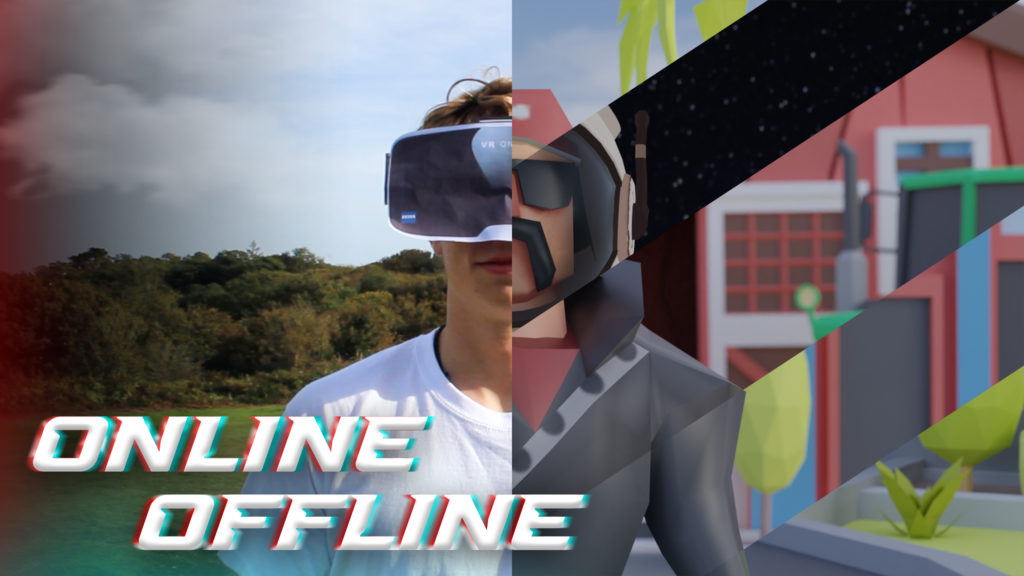
This is the final image which represents the whole NFT film. It shows the most important scene, which is the split scene that includes the animation as the NFT exhibition is called 2lives (online and offline), it shows the real world and the virtual meta verse.
We used our storyboard to organise our shoots, to know where/what/when we were going to shoot.
We decided that Michael was going to be Model 1, which would mostly be in the start of the video, and Reuben was Model 2, who was only in the last half of the video. Matt (me) was recording everything, and Ollie was the director and manager.
We had to make a VR headset using a printed off image of a VR headset and then we taped it to some sunglasses.
Shooting
First, we went to a open green area, which we filmed most of our scenes at.
We started off with the main walking headshot video, then we recorded the drone shots of Michael wearing the VR. After I recorded the scene where Michael and Reuben meet in real life and the last scene where they are talking on a bench.
After, we went to record the scene where Reuben takes off the VR headset at a gaming setup.
We couldn’t record a drone shot of a house, as you can’t fly within 50m of houses/property.
Editing
Once we had all the recordings Michael and Reuben started to edit the video on Adobe Premier Pro. They used special effects, such as the loading… visual effect, and static sound effect, etc. They also time-mapped some clips to match the beat of the music.

This shows the half and half effect, with the timeline on the bottom half of the screen.
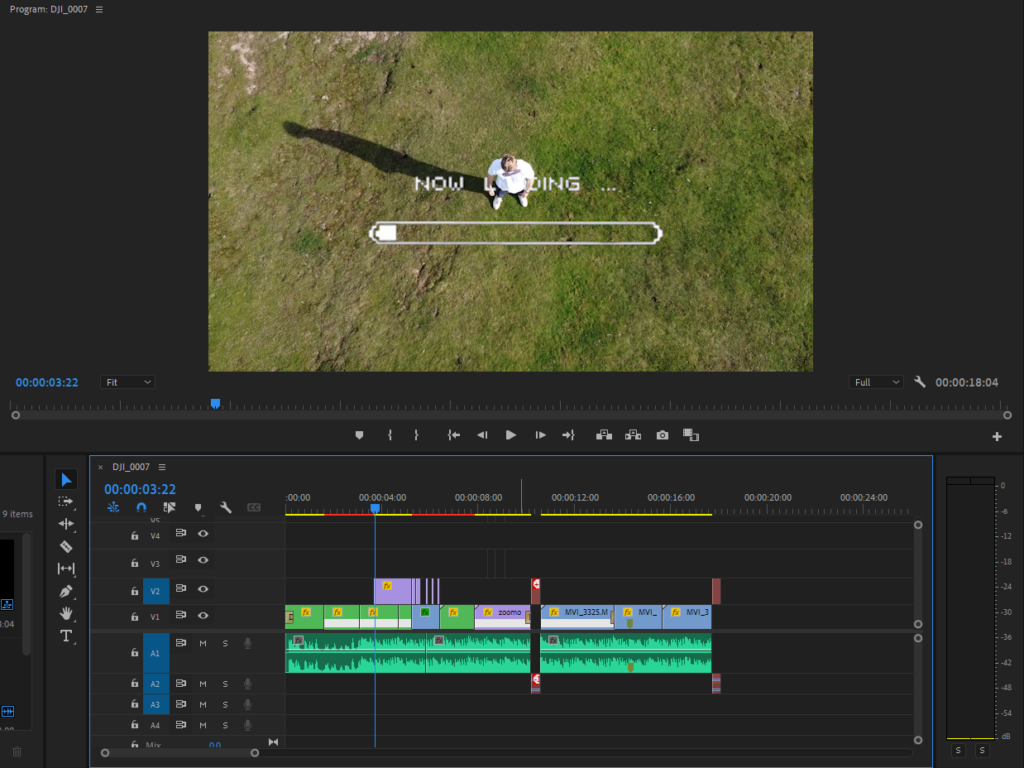
This is one of the special visual effects, which is used at the start of the video. Also, the timeline is zoomed out, so you can see all of the film on the timeline, and all its layers.

This is how the time-remapping was done, as seen on the left. He used key frame to change the speed of the clip at different time intervals.
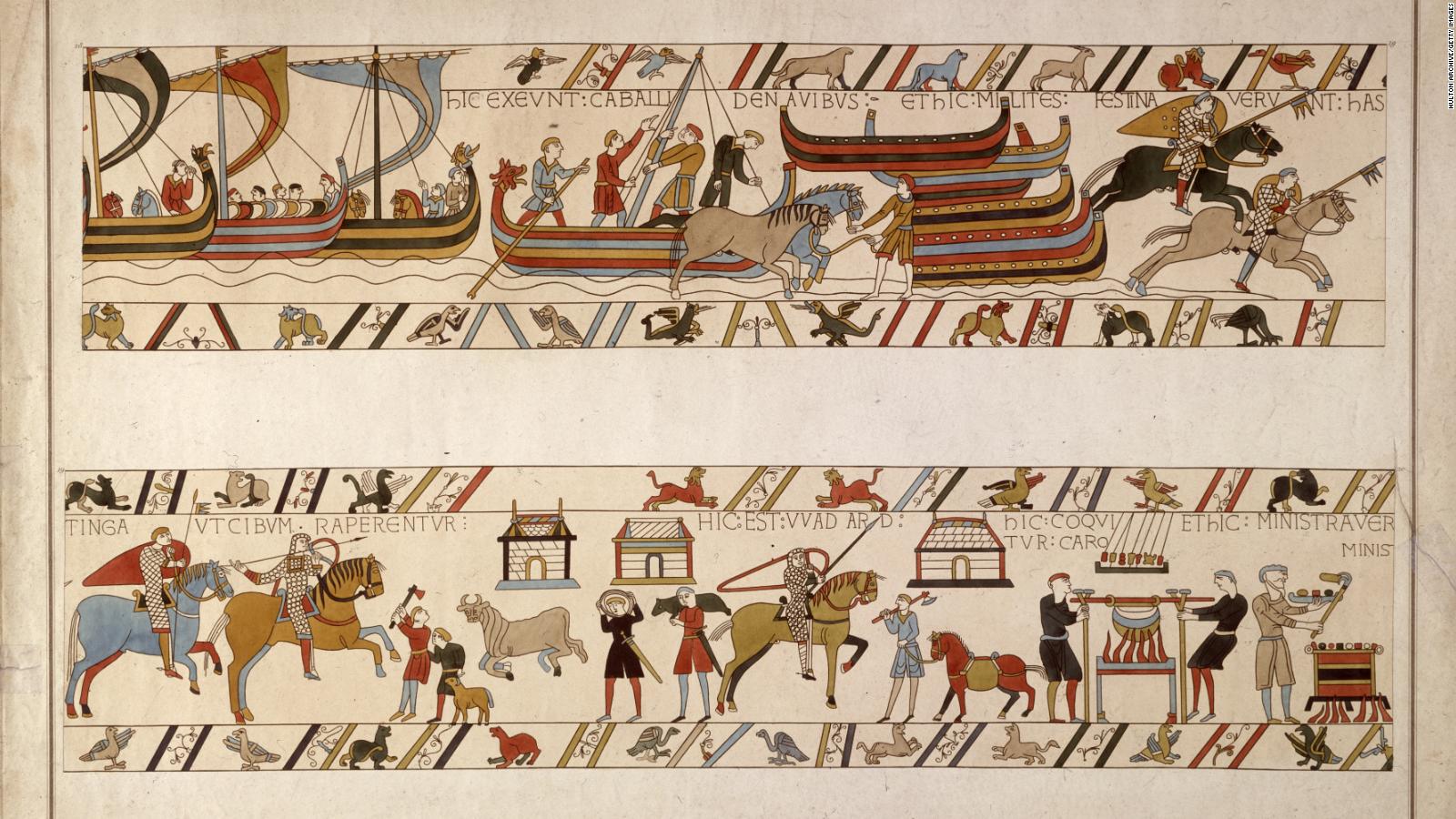
The Bayeux tapestry is an embroidered cloth which is nearly 70 metres (230 ft) long. It depicts the events leading up to the Norman conquest of England. It is presumed to date back to the 11th century, within a few years after the Battle of Hastings. It tells the story from the point of view of the conquering Normans but is now agreed to have been made in England. The cloth consists of some seventy scenes, many with Latin embroidered on linen with coloured woollen yarns. It is likely that it was commissioned by Bishop Odo, William the Conquers half-brother, and made in England – not Bayeux – in the 1070s. In 1729 the hanging was rediscovered by scholars at a time when it was being displayed annually in Bayeux Cathedral. The tapestry is now exhibited at the Musée de la Tapisserie de Bayeux in Bayeux, Normandy, France.
The Bayeux tapestry is embroidered in crewel (wool yarn) on a tabby-woven linen ground 68.38 metres long and 0.5 metres wide (224.3 ft × 1.6 ft) and using two methods of stitching: outline or stem stitch for lettering and the outlines of figures, and couching or laid work for filling in figures. Nine linen panels, between fourteen and three metres in length, were sewn together after each was embroidered and the joins were disguised with later embroidery. Later generations have patched the hanging in numerous places and some of the embroidery (especially in the final scene) has been reworked. The tapestry may well have maintained much of its original appearance – it now compares closely with a careful drawing made in 1730.
https://en.wikipedia.org/wiki/Bayeux_Tapestry#Construction,_design_and_technique

Yulia Makeyeva grew up in Russia and is now based in Jersey, Channel Islands. With a Linguistics degree, an education in Art History, silversmithing and jewellery making background, she turned her full attention to art in 2019. She experiments with different mediums, spanning photography, installations, video, collage, printmaking and traditional domestic crafts. She continually seeks and displays beauty through her work by arranging a contrasting array of materials from the household, industrial to organic matters collected outdoors into abstract forms. She participated in a Textile-based art exhibition in February 2020 in Jersey curated by the RampArts collective. For this exhibition, the curator had chosen works where the artist experimented with drapery, single threads, recycling, and objects covered with fabric.